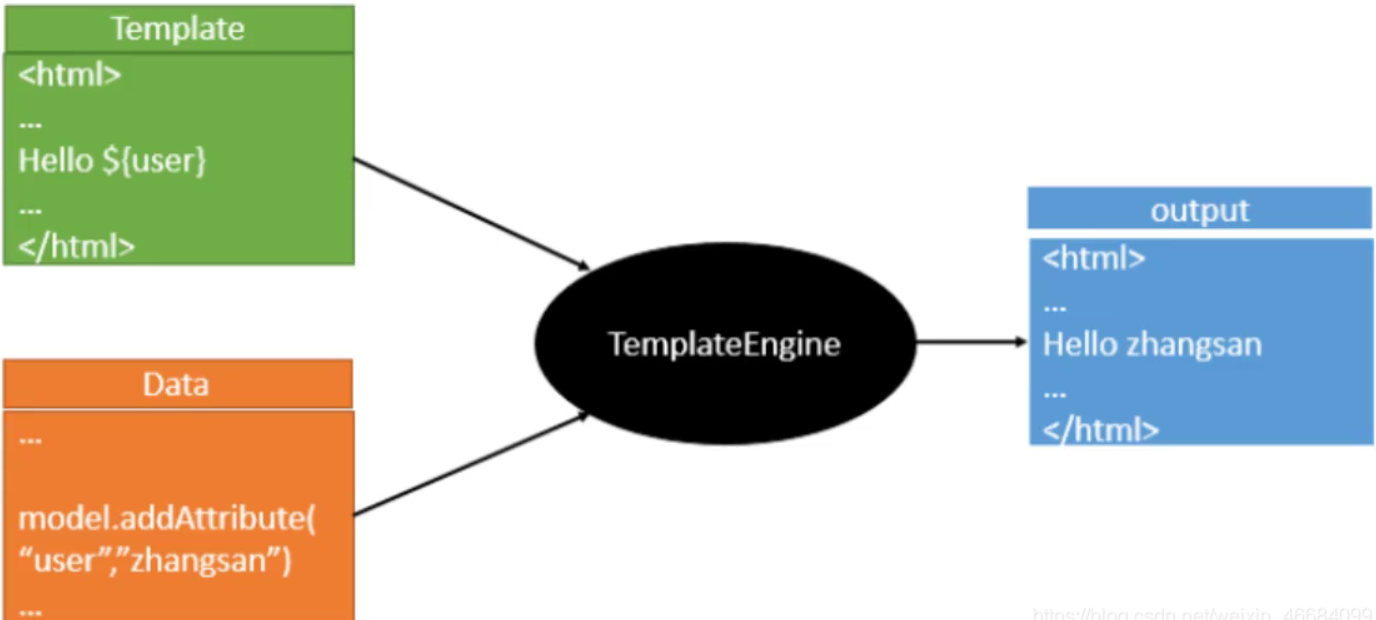SpringBoot-Web-初见
怎么开发一个网站?
目前后端通过修改基本都是可以实现,主要是前端还存在不少问题,所以还是推荐使用
- 模板,更改别人的,成为自己的
- 使用框架,组件,自己手动拼接
- 前端搞定:页面写出来
- 设计数据库(难点)
- 前端可以独立的自动运行,独立化工程
- 数据接口怎么对接:json,对象all in one
- 前后端联调测试
有一个熟悉的后台模板,前端页面自己可以组合出来一个网站的页面,让它独立运行。
静态资源
SpringMVC中所有静态资源或者页面应该放在web目录下,不能直接访问的会放在web/WEB-INF下
找到静态资源的存放目录
SpringBoot项目的静态资源应该放在哪个目录下?
WebMvcAutoConfiguration
//添加资源处理器
public void addResourceHandlers(ResourceHandlerRegistry registry) {
//如果静态资源已经被自定义了 那么就自定义的生效
if (!this.resourceProperties.isAddMappings()) {
logger.debug("Default resource handling disabled");
} else {
Duration cachePeriod = this.resourceProperties.getCache().getPeriod();
CacheControl cacheControl = this.resourceProperties.getCache().getCachecontrol().toHttpCacheControl();
//获取静态资源方式一:找到webjars/路径下的静态资源 (此方式了解即可 一般不使用)
if (!registry.hasMappingForPattern("/webjars/**")) {
this.customizeResourceHandlerRegistration(registry.addResourceHandler(new String[]{"/webjars/**"}).addResourceLocations(new String[]{"classpath:/META-INF/resources/webjars/"}).setCachePeriod(this.getSeconds(cachePeriod)).setCacheControl(cacheControl));
}
String staticPathPattern = this.mvcProperties.getStaticPathPattern();
//获取静态资源方式二: 获取当前目录下的静态资源 staticPathPattern
if (!registry.hasMappingForPattern(staticPathPattern)) {
this.customizeResourceHandlerRegistration(registry.addResourceHandler(new String[]{staticPathPattern})
.addResourceLocations(WebMvcAutoConfiguration.getResourceLocations(this.resourceProperties.getStaticLocations()))
.setCachePeriod(this.getSeconds(cachePeriod)).setCacheControl(cacheControl));
}
}
}
点进staticPathPattern继续查看源码,staticPathPattern代表/**
点进(this.resourceProperties.getStaticLocations())会发现以下路径定义
// 访问 /** 会去这几个目录下寻找静态资源
private static final String[] CLASSPATH_RESOURCE_LOCATIONS = new String[]
{"classpath:/META-INF/resources/",
"classpath:/resources/",
"classpath:/static/",
"classpath:/public/"};
优先级
| 目录 | 优先级 |
|---|---|
| resources | 高 |
| static | 中 |
| public | 低 |
扩展自定义路径
从源码的第一行我们可以看出,如果静态资源路径被自定义了,那么就会生效自定义的
# 在application配置文件中 设置如下 覆盖默认路径
spring.mvc.static-path-pattern=/tutony
首页定制
在WebMvcAutoConfiguration有:
//最后会被注入到bean
@Bean //欢迎页的处理映射
public WelcomePageHandlerMapping welcomePageHandlerMapping(ApplicationContext applicationContext, FormattingConversionService mvcConversionService, ResourceUrlProvider mvcResourceUrlProvider) {
WelcomePageHandlerMapping welcomePageHandlerMapping = new WelcomePageHandlerMapping(new TemplateAvailabilityProviders(applicationContext), applicationContext,
this.getWelcomePage(),
//可以寻找自定义欢迎页
this.mvcProperties.getStaticPathPattern());
welcomePageHandlerMapping.setInterceptors(this.getInterceptors(mvcConversionService, mvcResourceUrlProvider));
welcomePageHandlerMapping.setCorsConfigurations(this.getCorsConfigurations());
return welcomePageHandlerMapping;
}
// 在静态目录下寻找
private Optional<Resource> getWelcomePage() {
String[] locations = WebMvcAutoConfiguration.getResourceLocations(this.resourceProperties.getStaticLocations());
return Arrays.stream(locations).map(this::getIndexHtml).filter(this::isReadable).findFirst();
}
//返回静态资源目录下一个叫 index.html的文件
private Resource getIndexHtml(String location) {
return this.resourceLoader.getResource(location + "index.html");
}
因此从源码可以看出我们在静态资源目录下定义一个index.html文件
SpringBoot将自动识别为首页(欢迎页)
模板引擎Thymeleaf
前端交给我们的页面,是html页面。
如果是我们以前开发,我们需要把他们转成jsp页面,
SpringBoot这个项目首先是以jar的方式,不是war,像第二,我们用的还是嵌入式的Tomcat,所以呢,他现在默认是不支持jsp的。
那不支持jsp,如果我们直接用纯静态页面的方式,那给我们开发会带来非常大的麻烦,那怎么办呢,SpringBoot推荐你可以来使用模板引擎。
模板引擎有非常多,但再多的模板引擎,他们的思想都是一样的:

thymeleaf中文文档:https://raledong.gitbooks.io/using-thymeleaf/content/Chapter1/
员工管理系统-初见
员工管理系统-初见 地址:https://gitee.com/zwtgit/spring-boot-web
关于Thymeleaf相关的操作我就不说了,本人不推荐使用。
下面主要说一下SpringBoot的特殊操作。
国际化
什么是页面国际化?
我们在很多网站上看到的中英文切换,这个就叫做国际化
Spring Boot 和 Spring 一脉相承,对于国际化的支持,
默认是通过 AcceptHeaderLocaleResolver 解析器来完成的,
这个解析器,默认是通过请求头的 Accept-Language 字段来判断当前请求所属的环境的,进而给出合适的响应。
国际化实现
1.在resource目录下新建i18n(国际化单词的简写)文件夹
国际化,也叫 i18n,为啥叫这个名字呢?因为国际化英文是 internationalization ,
在 i 和 n 之间有 18 个字母,所以叫 i18n。
我们的应用如果做了国际化就可以在不同的语言环境下,方便的进行切换,
最常见的就是中文和英文之间的切换,国际化这个功能也是相当的常见。
2.创建Login.properties三个配置文件
Login_en_US.properties(英语)
Login.tip=Please sign in
Login.password=Password
Login.remenber=Remember me
Login.username=Username
Login.sign=Sign in
Login_zh_CN.properties(中文)
Login.tip=用户登录
Login.password=密码
Login.remenber=记住我
Login.username=用户名
Login.sign=登录
4.在springboot配置文件application.properties中指定国际化配置文件路径
# 配置国际化文件位置
spring.messages.basename=i18n.Login
5.在Thymeleaf中国际化的配置需要使用#{}包裹
编写国际化配置类
/**
* 国际化配置类
* 需要实现LocaleResolver
*/
public class MyLocaleResolover implements LocaleResolver {
//解析请求
@Override
public Locale resolveLocale(HttpServletRequest httpServletRequest) {
//获取请求中的语言参数
String languge = httpServletRequest.getParameter("l");
Locale locale = Locale.getDefault();//如果没有泽使用默认的
//如果请求的链接携带了国际化参数
if(!StringUtils.isEmpty(languge)){
//zh_CN
String[] s = languge.split("_");
//国际 地区
locale = new Locale(s[0], s[1]);
}
return locale;
}
@Override
public void setLocale(HttpServletRequest httpServletRequest, HttpServletResponse httpServletResponse, Locale locale) {
}
}
将国际化配置类放入spring容器
/**
* 扩展MVC
*/
@Configuration
public class MyMvcConfig implements WebMvcConfigurer {
/**
* 视图跳转
* 添加首页控制
* url:localhost:8080/ 跳转到首页
* url:localhost:8080/index.html 跳转到首页
* @param registry
*/
@Override
public void addViewControllers(ViewControllerRegistry registry) {
registry.addViewController("/").setViewName("index");
registry.addViewController("/index.html").setViewName("index");
}
/**
* 讲国际化配置放到spring容器管理
* @return 自定义的国际化配置
*/
@Bean
public LocaleResolver localeResolver(){
return new MyLocaleResolover();
}
}
页面国际化∶
- 我们需要配置
i18n文件 - 我们如果需要在项目中进行按钮自动切换,我们需要自定义一个组件
LocaleResolver - 记得将自己写的组件配置到spring容器
@Bean - 国际化使用:#{}
登陆功能
编写index.html设置请求路径
编写html
编写LoginController
/**
* 登录功能实现
*/
@Controller
public class LoginController {
//登录功能 伪造假数据
@RequestMapping("/user/login")
public String login(@RequestParam("username") String username, @RequestParam("password")String password, Model model){
if (!StringUtils.isEmpty(username.trim()) && password.trim().equals("123456")){
model.addAttribute("msg","登录成功");
return "redirect: /main.html"; //重定向
}
model.addAttribute("msg","账号或密码错误");
return "index";
}
}
编写MVC自定义配置
/**
* 视图跳转
* 添加首页控制
* url:localhost:8080/ 跳转到首页
* url:localhost:8080/index.html 跳转到首页
* @param registry
*/
@Override
public void addViewControllers(ViewControllerRegistry registry) {
registry.addViewController("/").setViewName("index");
registry.addViewController("/index.html").setViewName("index");
//登录重定向
registry.addViewController("/main.html").setViewName("dashboard");
}
拦截器
修改LoginController
修改LoginController代码,登录成功以后将用户信息放在session中:
//登录功能 伪造假数据
@RequestMapping("/user/login")
public String login(@RequestParam("username") String username, @RequestParam("password")String password, Model model, HttpSession httpSession){
if (!StringUtils.isEmpty(username.trim()) && password.trim().equals("123456")){
model.addAttribute("msg","登录成功");
httpSession.setAttribute("userLoginInfo",username);//登录成功以后将用户信息放置在Session中
return "redirect:/main.html"; //重定向
}
model.addAttribute("msg","账号或密码错误");
return "index";
}
编写拦截器
/**
* 自定义拦截器
* 拦截未登录的用户
*/
public class MyInterceptor implements HandlerInterceptor {
//判断用户是否登录 从session中判断
@Override
public boolean preHandle(HttpServletRequest request, HttpServletResponse response, Object handler) throws Exception {
//获取Session
HttpSession session = request.getSession();
//判断是否在登录页面
if(request.getRequestURI().contains("index")){
return true;
}
//判断是否登录过了
if(session.getAttribute("userLogin")!=null){
return true;
}
// 用户没有登陆跳转到登陆页面
request.setAttribute("msg","没有登录请先登录!");
request.getRequestDispatcher("/").forward(request, response);
return false;
}
}
在MVC自定义配置类中设置
//配置拦截器
@Override
public void addInterceptors(InterceptorRegistry registry) {
registry.addInterceptor(new MyInterceptor())
//拦截哪些请求
.addPathPatterns("/**")
//不拦截哪些请求 首页 登录请求 静态资源
.excludePathPatterns("/","/index.html","/user/login","/css/**","/js/**","/img/**");
}
SpringBoot-Web-初见的更多相关文章
- springboot+web文件上传和下载
一.首先安装mysql数据库,开启web服务器. 二.pom.xml文件依赖包配置如下: <?xml version="1.0" encoding="UTF-8&q ...
- 如何在spring-boot web项目中启用swagger
swagger的三个项目及其作用 我们打开swagger的官网,会发现有三个swagger相关的项目,它们分别是 swagger-editor 作用是通过写代码,生成文档描述(一个json文件或其他格 ...
- SpringBoot Web开发(5) 开发页面国际化+登录拦截
SpringBoot Web开发(5) 开发页面国际化+登录拦截 一.页面国际化 页面国际化目的:根据浏览器语言设置的信息对页面信息进行切换,或者用户点击链接自行对页面语言信息进行切换. **效果演示 ...
- SpringBoot Web开发(4) Thymeleaf模板与freemaker
SpringBoot Web开发(4) Thymeleaf模板与freemaker 一.模板引擎 常用得模板引擎有JSP.Velocity.Freemarker.Thymeleaf SpringBoo ...
- SpringBoot Web项目中中如何使用Junit
Junit这种老技术,现在又拿出来说,不为别的,某种程度上来说,更是为了要说明它在项目中的重要性. 凭本人的感觉和经验来说,在项目中完全按标准都写Junit用例覆盖大部分业务代码的,应该不会超过一半. ...
- SpringBoot Web篇(二)
摘要 继上一篇 SpringBoot Web篇(一) 文件上传 当我们服务器需要接收用户上传的文件时,就需要使用MultipartFile作为参数接收文件.如下: @PostMapping(" ...
- SpringBoot web获取请求数据【转】
SpringBoot web获取请求数据 一个网站最基本的功能就是匹配请求,获取请求数据,处理请求(业务处理),请求响应,我们今天来看SpringBoot中怎么获取请求数据. 文章包含的内容如下: 获 ...
- springboot web项目创建及自动配置分析(thymeleaf+flyway)
@ 目录 源码分析 webjars thymeleaf thymeleaf语法 springmvc 启动配置原理 集成flyway插件 springboot 创建web项目只需要引入对应的web-st ...
- SpringBoot Web 学习
SpringBoot Web 开发 静态资源 打开WebMvcAutoConfiguration类里面的静态类WebMvcAutoConfigurationAdapter里面的addResourceH ...
- SpringBoot Web学习笔记
一.资源的访问: 情形一.所有的 /webjars/** 都会去 classpath:/META_INFO/resource/webjars/ 下找资源: webjars:以jar包的方式引入静态 ...
随机推荐
- 【SpringCloud技术专题】「原生态Fegin」打开Fegin之RPC技术的开端,你会使用原生态的Fegin吗?(上)
前提介绍 Feign是SpringCloud中服务消费端的调用框架,通常与ribbon,hystrix等组合使用. 由于遗留原因,某些项目中,整个系统并不是SpringCloud项目,甚至不是Spri ...
- WPF DataGrid DataGridTextColumn
Style设置时,无法绑定到数据,需要这样写 1 <DataGridTextColumn Header="呵呵" Binding="{Binding ID}&quo ...
- 如何实现让div垂直居中,左右10px,高度始终为宽度一半
方法一:利用height:0; padding-bottom: 50%; <!DOCTYPE html><html lang="en"> <head& ...
- 【笔记】scikit-learn中的Scaler(归一化)
scikit-learn中的数据归一化 在机器学习使用数据归一化的时候有一个重要的注意事项 我们对训练数据进行均值和方差的处理,得到mean_train以及std_train,但是在对测试数据进行归一 ...
- 解决uni-file-picker组件在ios点击失效的问题
从组件源码里找到choose-and-upload-file.js文件,查找chooseAndUploadFile方法,在方法里添加下面代码,保存即可解决. opts.sourceType = ['a ...
- AWS(amazon ec2)服务器流量查询
aws ec2流量监控 亚马逊云服务新用户绑定信用卡免费使用一年,相信很多人白嫖过,选用micro最低配置+流量免费15G,包含上下行.这种配置用来测试玩玩还行,生产使用的话容易超标.很多人想知道流量 ...
- NOIP 模拟 9 数颜色
题解 一道裸的数据结构题 正解是排序 \(+\) 二分,但是这怎么能有动态开点线段树好写呢? 于是我就打了暴力,骗了五十分. 对于每种颜色,我们在下标上开一颗线段树,对于交换若颜色相同则跳过,否则直接 ...
- zoolkeeper 的Curator的分布式锁
RetryPolicy retryPolicy = new ExponentialBackoffRetry(1000, 3) CuratorFramework client = CuratorFram ...
- windows通过pfx文件生成key、crt文件
nginx代理的时候,需要填写证书的crt跟rsa文件路径,通过iis导出的证书是pfx文件(不知道nginx能不能直接用pfx文件,没有查看过相关资料),所以要通过pfx文件生成crt.rsa文件. ...
- Java异常与异常处理
异常体系结构 1.所有异常都继承于Throwable类,其下有两大子类: (1)Error类:错误,一般编程人员不太接触,如虚拟机错误.线程死锁.硬伤:使程序崩溃 (2)Exception类:异常,编 ...
